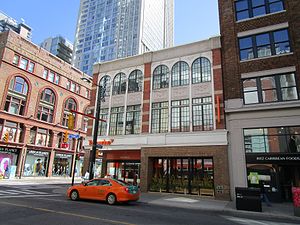Rialto Theatre (Toronto, Yonge)
Jump to navigation
Jump to search
The John E. Thompson block is a heritage structure at the corner of Yonge and Shuter streets.[1] It was built in 1894, and renovated in 1904 and 1920. In 1900 it housed the Yonge Street Mission. According to Now Playing: Early Moviegoing and the Regulation of Fun, it was operating as a movie theatre, in the Griffin chain, in 1907.[2]
In 2011 the teller-less bank Tangerine renovated the building, and opened it as an access centre.[3] The third floor, closed to the public, houses a call centre. While the first two floors house a WiFi centre, workspace and cafe for current and potential patrons.
References
- ↑ Variances from Chapter 297, Signs, of the Former City of Toronto Municipal Code - 221 Yonge Street (Toronto Centre-Rosedale, Ward 27), City or Toronto, 2002-05-21. Retrieved on 2017-05-21. “The site is located at the southeast corner of Yonge Street and Shuter Street. The property is zoned for mixed uses (CR) and is occupied by a three-storey heritage commercial building. The John E. Thompson Block was constructed in 1886 and altered for various owners between 1904 and 1920. The property was listed in the Inventory of Heritage Properties by Toronto City Council on November 21 & 23, 1973.”
- ↑ Paul S. Moore. Now Playing: Early Moviegoing and the Regulation of Fun. SUNY Press. ISBN 9780791478431. Retrieved on 2017-05-21.
- ↑ Michelle F.. ING launches cafe, workspace at Yonge & Shuter, BlogTO, 2011-04-29. Retrieved on 2017-05-21. “The building's new usage is a far cry from its origins - in and around the turn of the century it housed such tenants as a barber, tailor, shoemaker and billiard room.”
